 Overview
Overview
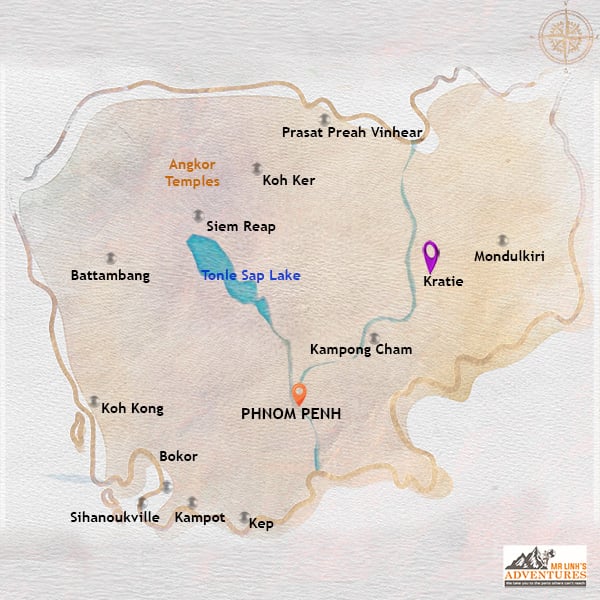 Kratie
Kratie, located in the province of the same name, is a charming town in northeastern Cambodia, bordered by the mighty Mekong River. Less crowded than other Cambodian destinations, Kratie offers a peaceful and authentic atmosphere, ideal for travelers seeking off-the-beaten-path discoveries.
While it's possible to explore farmlands and nature reserves elsewhere in the province of Kratie, the heart of this region lies within the city and along the Mekong, which traverses the province from end to end. In fact, 80% of the population of Kratie province lives along the Mekong River. While the city itself is full of French colonial elegance, the river is home to Irrawaddy dolphins, an endangered species, and hundreds of islands.
Giving an inspiring insight into the Cambodian way of life, a visit to Kratie is full of nature, culture and warm hospitality.
 Top Attractions
Top Attractions
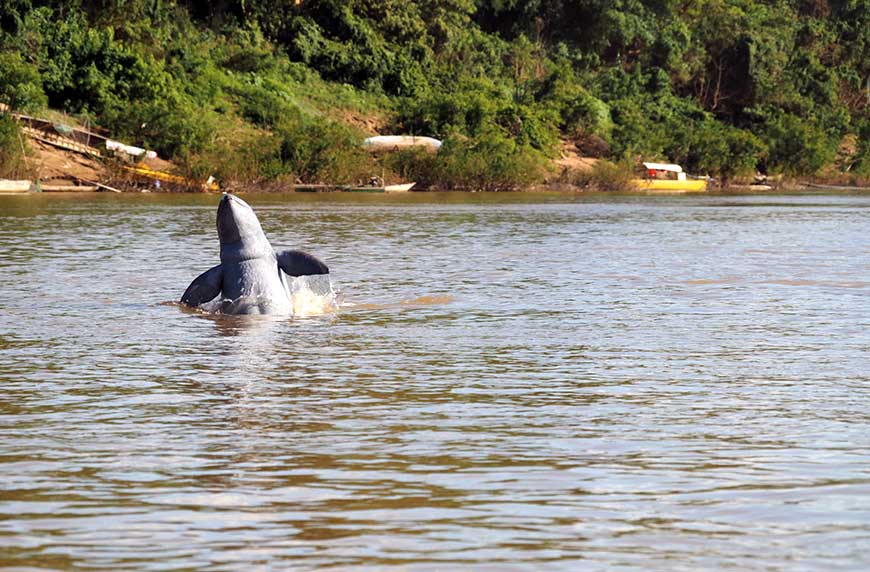 Irrawaddy dolphins represent the biodiversity of the Mekong, often seen in the eastern town of Kratie.
Irrawaddy dolphins represent the biodiversity of the Mekong, often seen in the eastern town of Kratie.
Kratie, a peaceful city bordering the Mekong, is a charming destination in Cambodia, renowned for its tranquility and unspoilt nature. Here are the experiences not to be missed during your visit:
Meeting with the dolphins of Irrawaddy
Kratie is one of the few sanctuaries where you can still observe the dolphins of Irrawaddy, an endangered species of freshwater dolphin. Boat trips are offered to approach these fascinating creatures in their natural environment. It is a unique and moving experience, offering a privileged overview of the local wildlife.
Escape on the island of Koh Trong
The island of Koh Trong, a true haven of peace in the middle of the Mekong, is the ideal place to escape the bustle. Rent a bike and explore its trails to discover authentic fishing villages, green rice fields and lush orchards. The atmosphere is incredibly relaxing, inviting contemplation and discovery of rural Cambodian life.
Panoramic view from the Phnom Sambok Temple
Perched on a hill, the Temple of Phnom Sambok offers a breathtaking view of the Mekong and the surrounding countryside. Beyond its importance as a place of worship for Cambodians, it is also a captivating historical site, ideal for admiring the landscape and soaking in local spirituality.
Immersion in the Kratie market
The local market in Kratie is a true kaleidoscope of colours, sounds and flavours. This lively place is perfect for discovering fresh local products, tasting Cambodian culinary specialties and finding traditional crafts. It’s a guaranteed immersion in the local culture and an excellent opportunity to shop for some souvenirs.
 See & Do
See & Do
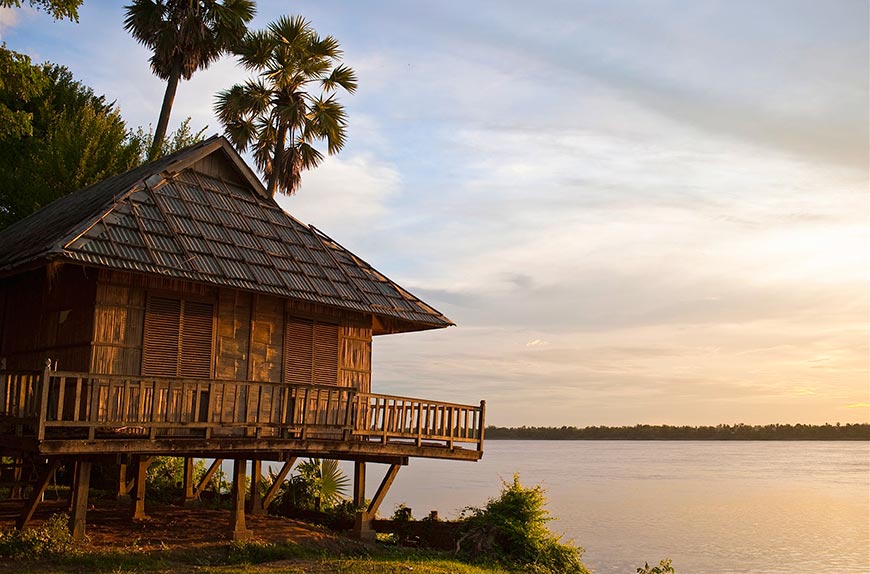 A traditional house by the Mekong River
A traditional house by the Mekong River
Kratie, a city with authentic charm to discover
Kratie is a true gem to explore on foot, by bicycle, or motorcycle. Stroll through the streets, admire the local architecture, and soak up the peaceful atmosphere of this riverside city.
Why not follow along the majestic Mekong River and discover authentic villages, true witnesses of the region's cultural richness? Adventure enthusiasts can even embark on the "Mekong Riverside Trail," a winding path leading through idyllic landscapes.
Kratie is also known for hosting a population of Irrawaddy dolphins, an endangered species. Embark on a boat or kayak excursion and experience an unforgettable encounter with these fascinating animals up close.
Koh Trong Island, accessible by ferry, transports you to a haven of peace. Wander through the picturesque village, meet the warm locals, and soak up the laid-back atmosphere that prevails there.
Kratie also offers many other natural treasures, such as the Chum Pey waterfalls or the Rut Cham Pey temple. Not to forget the local market, the beating heart of the city, where you will discover the flavors and artisanal products of the region.
 Go Green
Go Green
Mr Linh's Adventures offers tailor-made tours in the Kratie region, designed for travelers in search of authenticity and sharing:
"Authentic Kratie Tour": Explore the highlights of Kratie, meet local communities, and discover the cultural and natural richness of the region.
"Mekong Adventure Tour": Embark on an expedition on the river, observe Irrawaddy dolphins, visit floating villages, and discover the wild landscapes of the Mekong.
"Trekking and Encounters Tour": Hike in the jungle, meet indigenous communities, and share their way of life and traditions.
 Heritage
Heritage
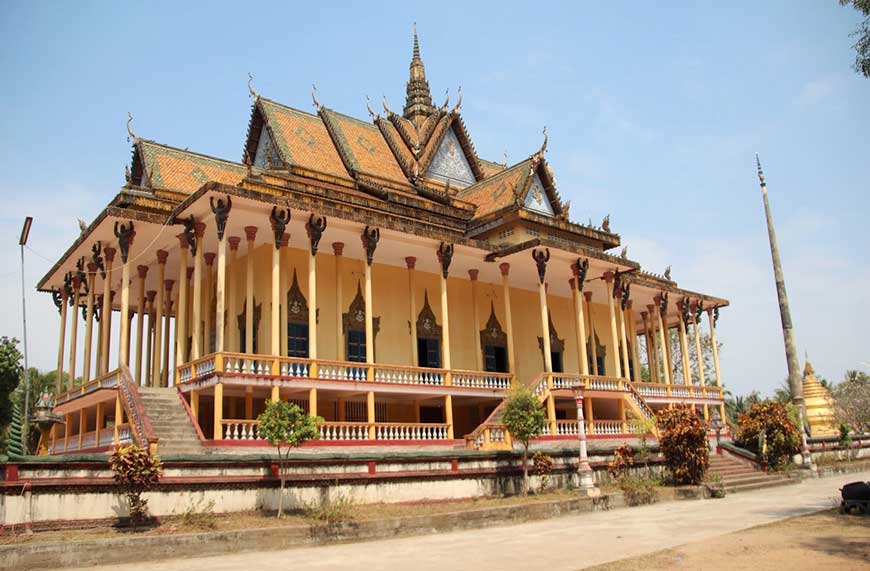 Wat Sorsor Moi Roi or 100 Columns Temple, is the largest pagoda in Cambodia
Wat Sorsor Moi Roi or 100 Columns Temple, is the largest pagoda in Cambodia
Kratie, a city with multiple spiritual facets
Beyond its rich architectural heritage, Kratie is home to many fascinating temples and places of worship that invite visitors to serenity and spiritual discovery.
Wat Sray Sahn-tah-rah-boh stands out for its beauty and enchanting location on the banks of the Mekong River. Immerse yourself in its peaceful atmosphere, admire the details of its colorful architecture, and perhaps even have the chance to interact with the monks.
But don't limit yourself to this main temple. Explore the hidden gems nearby, such as Wat Roka Kandal, a peaceful haven away from the hustle and bustle. Or Phnom Sombok, which offers stunning views of Kratie and the river, especially at sunset.
Another fascinating site is Wat Sorsor Moi Roi, also known as the "temple of a hundred columns." Its captivating history, blending legends and tragedies, makes it a unique place of its kind.
And within this temple, there is a center dedicated to the conservation of Mekong turtles, an endangered species. You may have the chance to witness the moving spectacle of releasing these precious little creatures back into their natural habitat.
Spiritual and naturalistic experiences beyond the ordinary await you in Kratie, beyond its architectural charms. An invitation to serenity and the discovery of Cambodian cultural riches.
 Food & Drinks
Food & Drinks
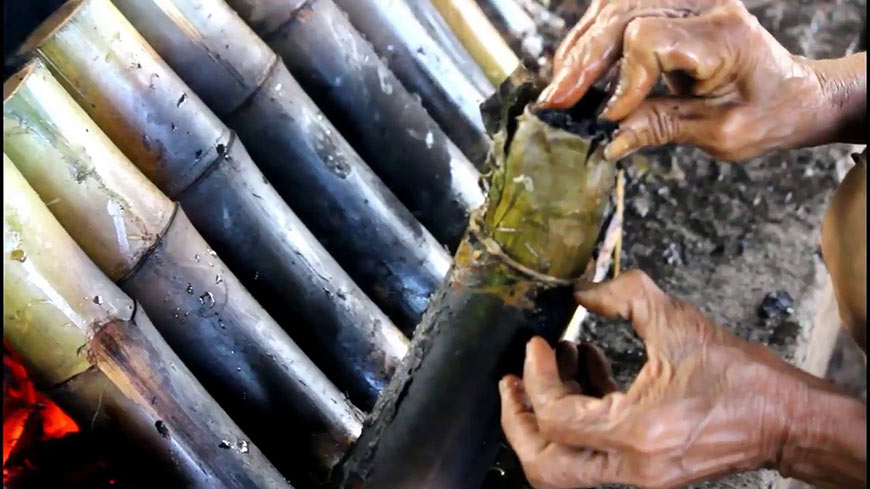 Krolan, a Cambodian local food made with sticky rice and bean
Krolan, a Cambodian local food made with sticky rice and bean
A river city on the banks of the Mekong, Kratie offers culinary specialties that often highlight the products of the river, notably fish. Here are some of the specialties not to be missed:
Nem (Fermented fish wrapped in banana leaves): This is one of the most iconic specialties of Kratye, reflecting local conservation know-how. The nem is prepared from finely chopped freshwater fish (carp, catfish, snake fish, etc.), mixed with garlic, chili pepper, roasted rice powder and salt, sometimes local herbs. The whole is then fermented in banana leaves for several days, which gives it a slightly acidic, spicy and very fragrant flavor. It is often enjoyed with fresh vegetables, rice cakes or as a snack.
Krolan (Glutinous rice cooked in bamboo): It is a very popular snack in Cambodia, and Kratie is particularly renowned for its krolan. It is glutinous rice mixed with coconut milk, beans (often black peas), then slowly cooked inside a bamboo tube. The result is a sweet and fragrant dessert or snack, which one eats by "peeling" the bamboo.
Mekong dried fish: With the abundance of fish in the Mekong, dried fish is a local specialty. It can be found in markets and is often used in various Cambodian dishes or consumed as such.
Kuy Teav Khor Ko (Traditional Beef Noodle Soup): Although it is a dish that can be found all over Cambodia, the version of Cratie can have its own nuances and flavors, often based on fresh local ingredients. It’s a rice noodle soup with beef and rich broth.
Prahok (Fermented fish paste): It is a fundamental and ubiquitous ingredient in Cambodian cuisine, and although it is not a "specialty of Kratye" in itself, being a fishing town, prahok is produced and used in abundance. Its flavor is very pronounced and authentic, and it is often the basis of many sauces and dishes.
 Directions
Directions
Location
Kratie is located in northeastern Cambodia, about 300 km from Phnom Penh.
How to get there
♦ From Hanoi: There are no direct flights between Hanoi and Kratie. You need to take a flight to Phnom Penh, then a bus or taxi to Kratie.
♦ From Ho Chi Minh City: There are no direct flights between Ho Chi Minh City and Kratie. You need to take a flight to Phnom Penh, then a bus or taxi to Kratie.
Ticket Price: The price of the airplane ticket varies depending on the airline and the time of year. The price of the bus or taxi between Phnom Penh and Kratie is around 10to10 to 10to20.
Best Season
The best time to visit Kratie is from November to March, during the dry season, when the weather is sunny and pleasant.